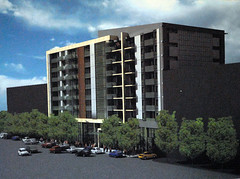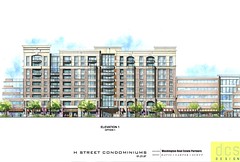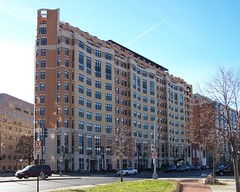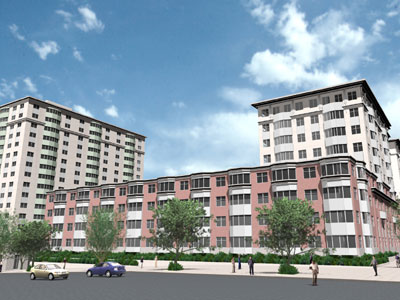Speaking of urban design
1. Before, project for the 600 block of H Street NE as first proposed at community meeting in August. Photo by David Klavitter

2. After hundreds of hours of community involvement, including a very contentious set of hearings before the Board of Zoning Adjustment.

Maybe it's just a matter of achieving mediocrity, I don't know. Compared to buildings like 400 Massachusetts Avenue NW, or 1 Mass Court, I wish we could have done better. On the other hand, you can only expend so much energy.

Mass Court Apartments, 300 H Street NW. Photo by Dan Malouff, Beyond DC.

Condominiums at 400 Massachusetts Avenue NW. Architect: Phil Esocoff. Photo by Dan Malouff, Beyond DC.
ANC6A's Drew Ronneberg (the building is in ANC6C but within the 200 foot boundary of ANC6A) took the lead on getting this project to adhere to H Street's new design guidelines as part of the Neighborhood Commercial Overlay Zoning District for the street. (The H Street section is not yet included in the previously cited material.)
Whoever says that urban design doesn't matter and shouldn't be the leading element in the Comprehensive Plan... well, I beg to differ. Urban design and architectural design quality is very difficult to achieve under the current regulatory regime, which accords almost no notice of quality design, and provides little in the way of requirements and inducements.
As to the question "Is this the best you could do?," well, yes, given the current regulations. And compared to other neighborhood commercial districts lacking design guidelines (other than H Street, only historically designated commercial districts require design review), H Street has an opportunity to achieve better design.
However, it is held hostage to a lack of knowledge generally, the amount of time required, and the failure of most neighborhood organizations to step up and demand more and better.
How do you think this compares to this approved design of a development on the 200 block of K Street NE, which as a PUD, did have a modicum of design review?

Rendering, 200 K Street NE.
Expecting to get a group of citizens that are knowledgeable and able to spend 600 or more hours for each new building/site planning project is unreasonable and unrealizable. There were a few really great people (some new to these kinds of processes) that came together to address the 600 H Street NE project. That kind of civic talent is uncommon and not easily identifiable in every nook and cranny of the city.
Index Keywords: urban-design-placemaking



0 Comments:
Post a Comment
<< Home